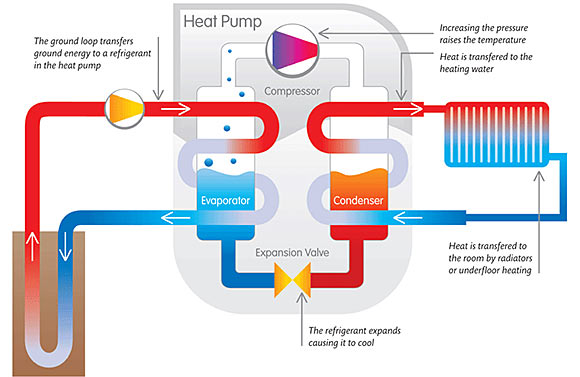How Geothermal Heat Pumps Work
Geothermal heat pumps move heat from one place to another - from outside to inside a home, for example. That's why they're called "heat pumps." All heat pumps have an outdoor unit (called a condenser) and an indoor unit (an evaporator coil).
A substance called a refrigerant carries the heat from one area to another. When compressed, it is a high temperature, high-pressure liquid. If it is allowed to expand, it turns into a low temperature, low pressure gas. The gas then absorbs heat.

In the winter the normal heat pump system extracts heat from outdoor air and transfers it inside where it is circulated through your home's ductwork by a fan.
Even cold air contains a great deal of heat; the temperature at which air no longer carries any heat is well below -200 degrees Fahrenheit. That's why geothermal heat pumps are so efficient. Geothermal heat pumps are similar to ordinary heat pumps, but instead of using heat found in outside air, they rely on the stable, even heat of the earth to provide heating, air conditioning and, in most cases, hot water.
Though many parts of the country experience seasonal temperature extremes, afew feet below the earth's surface the ground remains at a relatively constant temperature. Although the temperatures vary according to latitude, at six feet underground, temperatures range from 45 degrees to 75 degrees Fahrenheit.
Ever been inside a cave in the summer? The air underground is a constant, cooler temperature than the air outside. During the winter, that same constant cave temperature is warmer than the air outside.
That's the principle behind geothermal heat pumps. In the winter, they move the heat from the earth into your house. In the summer, they pull the heat from your home and discharge it into the ground.
Studies show that approximately 70 percent of the energy used in a geothermal heat pump system is renewable energy from the ground. The earth's constant temperature is what makes geothermal heat pumps one of the most efficient, comfortable, and quiet heating and cooling technologies available today. While they may be more costly to install initially than regular heat pumps, they can produce markedly lower energy bills - 30 percent to 40 percent lower, according to estimates from the U.S. Environmental Protection Agency, who now includes geothermal heat pumps in the types of products rated in the EnergyStar® program. Because they are mechanically simple and outside parts of the system are below ground and protected from the weather, maintenance costs are often lower as well.
How Does The Geothermal Heat Pump Work?
Remember, a geothermal heat pump doesn't create heat by burning fuel, like a furnace does. Instead, in winter it collects the Earth's natural heat through a series of pipes, called a loop, installed below the surface of the ground or submersed in a pond or lake. Fluid circulates through the loop and carries the heat to the house. There, an electrically driven compressor and a heat exchanger concentrate the Earth's energy and release it inside the home at a higher temperature. Ductwork distributes the heat to different rooms.
In summer, the process is reversed. The underground loop draws excess heat from the house and allows it to be absorbed by the Earth. The system cools your home in the same way that a refrigerator keeps your food cool - by drawing heat from the interior, not by blowing in cold air.
The geothermal loop that is buried underground is typically made of high-density polyethylene, a tough plastic that is extraordinarily durable but which allows heat to pass through efficiently. When installers connect sections of pipe, they heat fuse the joints, making the connections stronger than the pipe itself. The fluid in the loop is water or an environmentally safe antifreeze solution that circulates through the pipes in a closed system.
Another type of geothermal system uses a loop of copper piping placed underground. When refrigerant is pumped through the loop, heat is transferred directly through the copper to the earth.
As an added benefit, systems can be equipped with a device called a "desuperheater" can heat household water, which circulates into the regular water heater tank. In the summer, heat that is taken from the house and would be expelled into the loop is used to heat the water for free. In the winter, the desuperheater can reduce water-heating costs by about half, while a conventional water heater meets the rest of the household's needs. In the spring and fall when temperatures are mild and the heat pump may not be operating at all, the regular water heater provides hot water.
How Do Geothermal Heat Pumps Compare?
Surveys taken by utilities have found that homeowners using geothermal heat pumps rate them highly when compared to conventional systems. Figures indicate that more than 95 percent of all geothermal heat pump owners would recommend a similar system to their friends and family.
Heat Pump Durability
Geothermal heat pumps are durable and require little maintenance. They have fewer mechanical components than other systems, and most of those components are underground, sheltered from the weather. The underground piping used in the system is often guaranteed to last 25 to 50 years and is virtually worry-free. The components inside the house are small and easily accessible for maintenance. Warm and cool air are distributed through ductwork, just as in a regular forced-air system.
Since geothermal systems have no outside condensing units like air conditioners, they are quieter to operate.
Geothermal Binary Cycle Power Plants copyright 2011 Digtheheat.com
